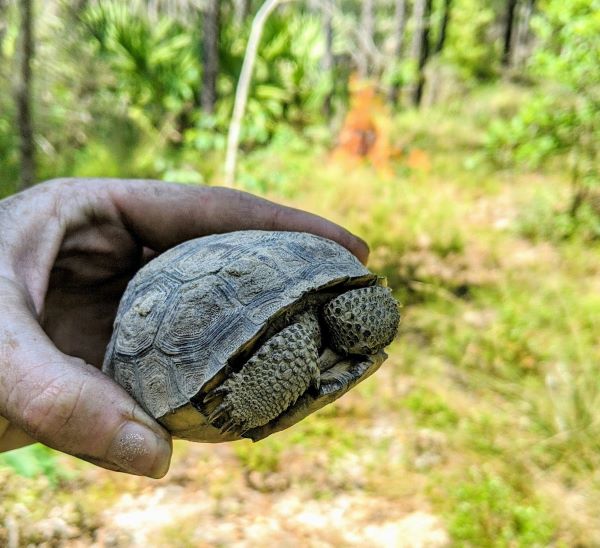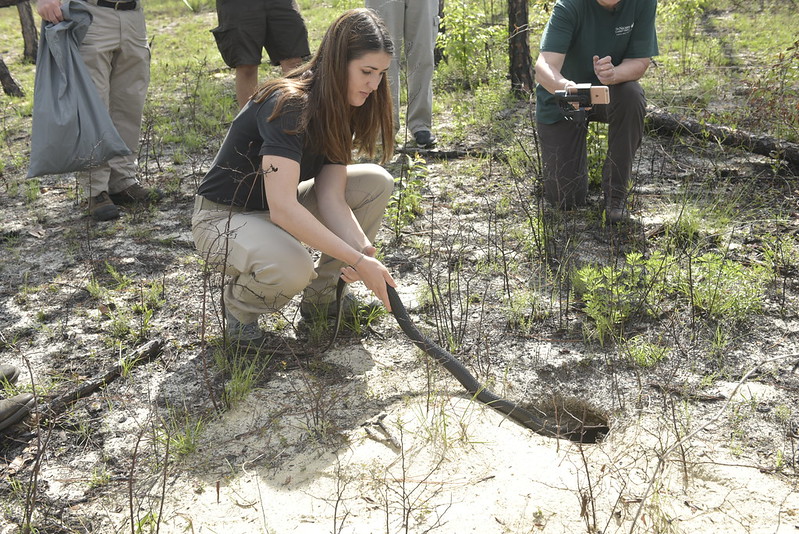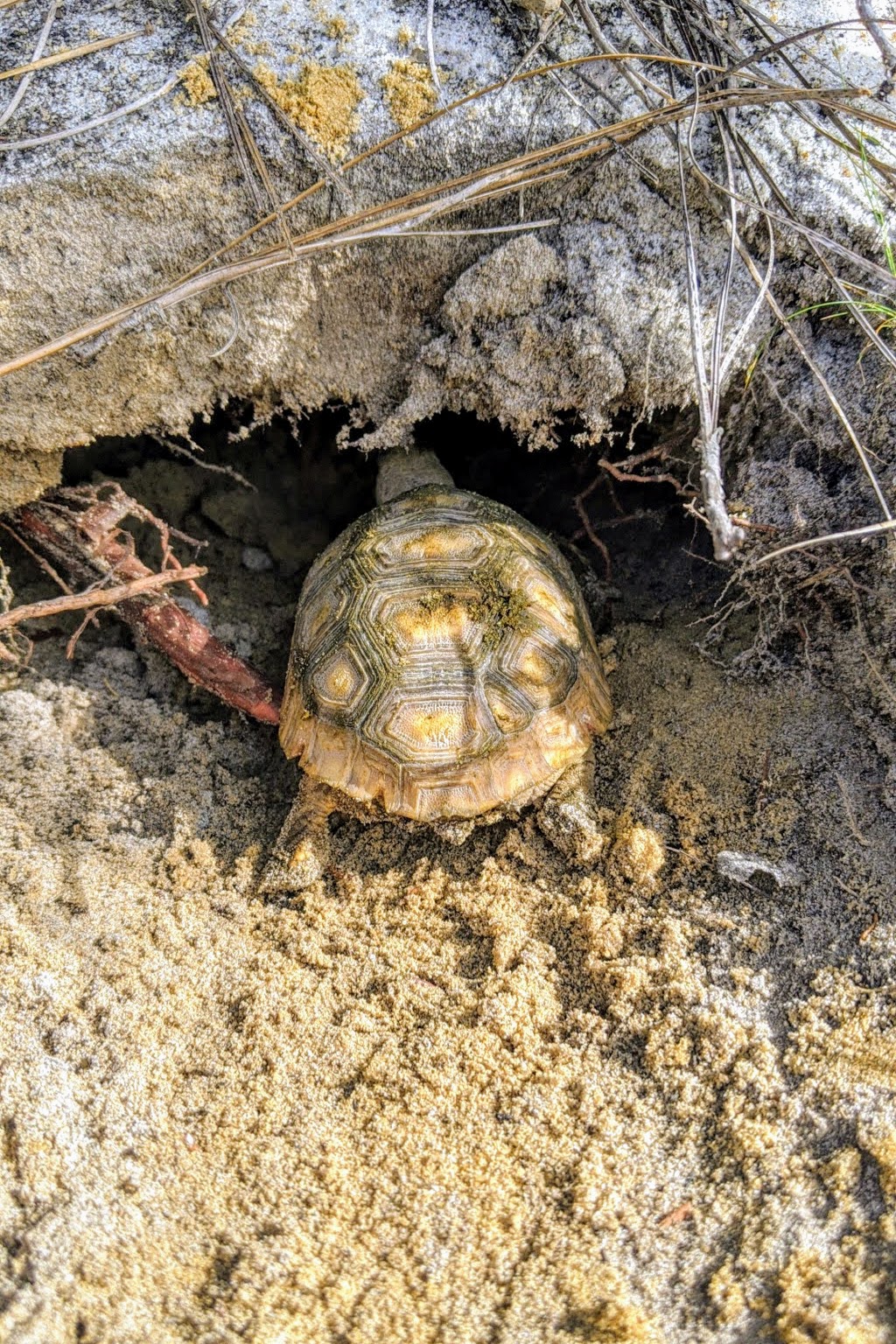Need to catch up with gopher tortoise updates from your state? Read about the highlights in our annual state report summaries.

Alabama Summary
In Alabama, the gopher tortoise is federally listed under the Endangered Species Act (ESA) in the western portion of its range (Mobile, Washington and Choctaw counties) and currently a candidate species for listing in the eastern portion, which includes twenty-three southern Alabama counties.
The State of Alabama permanently protects and manages approximately 26,000 acres of tortoise habitat on public lands. The Alabama DCNR, Division of Wildlife and Freshwater Fisheries, and the State Lands Division continue to work together to restore and maintain gopher tortoise habitat on DWFF, Forever Wild Land Trust, and SLD lands.
DWFF continues work towards determining a more accurate gopher tortoise population estimate and distribution in Alabama. Gopher tortoise surveys on public lands using Line Transect Distance Sampling (LTDS) methodology were completed in Oct 2017.
Several targeted landowner meetings took place throughout the fiscal year educating landowners on the status of the tortoise in AL and throughout the range. These workshops have been, so far, well received as landowners are now contacting DWFF and partners to learn more about how they can assist with the conservation of the species and to offer access for LTDS surveys.
There have been no targeted relocation efforts from private lands this year. To date, six gopher tortoises were placed in a one-acre enclosure built in summer 2020 at Geneva State Forest. All tortoises were soft released and will remain in the enclosure for 6-12 months after which the enclosure will be removed.
In February 2020 DWFF staff organized and facilitated the 5th Alabama Tortoise Alliance (ALTA) meeting. ALTA is a partnership that includes private industrial and non-industrial landowners, state, tribal and federal agencies, local governments, organizations and businesses. The purpose of ALTA is to foster an increased level of communication, collaboration and conservation among the stakeholders to actively manage and conserve gopher tortoise populations and habitat in Alabama so that the species no longer warrants state or federal protection.
Education and outreach activities were mostly canceled this year due to COVID-19. Social media was our main vehicle in educating the public about gopher tortoises and their habitat.
Florida Summary

Florida continues to implement conservation actions listed in the Gopher Tortoise Management Plan (2007, revised in 2012).
The Florida Fish and Wildlife Conservation Commission’s (FWC) Gopher Tortoise Permitting Guidelines were revised and approved by Commissioners on July 23rd, 2020. These guidelines clarify protections, outline activities where permits are needed, and provide methods and qualifications for individuals conducting gopher tortoise relocations or surveys.
In Florida, efforts continue to evaluate gopher tortoise populations on conservation lands using the Line Transect Distance Sampling (LTDS) method; 49 of 84 surveyed sites meet criteria for a viable population.
Over $150,000 in funding has been awarded this year to assist local governments with habitat management activities on >575 acres of conservation lands.
Check out Florida’s new gopher tortoise sighting web app! With this app, community scientists can report sightings of healthy gopher tortoises, burrows, mortalities, and sick or injured tortoises.
To promote actionable science, FWC is funding scientific research on an annual basis using gopher tortoise mitigation contributions. To learn more, visit FWC's Call for Research and Outreach Proposals webpage.
Georgia Summary

The Gopher Tortoise Initiative (GTI) is a Georgia-based effort that aims to protect at least 65 tortoise populations that meet or exceed the current USFWS standard for a minimum viable population (MVP; >250 adult tortoises). The state is currently on track to have 61 of the 65 populations protected by 2022.
The Georgia Department of Natural Resources (GADNR) was awarded a grant that funded two new full-time positions focused on gopher tortoise conservation. Marylou Moore has been hired as the new Gopher Tortoise Biologist, and Jacob Wilson accepted the Gopher Tortoise Technician Position. In addition to these positions, the grant is also funding a new prescribed fire crew which will focus on high priority gopher tortoise habitat.
During fiscal year 2020, the GADNR Wildlife Conservation Section’s tortoise survey crew completed LTDS surveys on six sites. The largest effort was extended at Ceylon WMA, which has over 3,000 acres of tortoise habitat. The estimate for the tortoise population on Ceylon is 2,990, at a density of 2.3 per hectare, likely occurring as four distinct populations. Additionally, 50-60 gopher frogs and a number of other rare species were also encountered during the survey period. It remains to be seen, but it looks like there may be as many as six to eight different breeding areas for the gopher frogs.
During testing of waifs and other displaced tortoises this year, seven adults were discovered to be positive for Upper Respiratory Tract Disease (URTD). Georgia DNR identified the R.J. Reynolds WMA on Sapelo Island as a site where these tortoises could be relocated without the risk of transmitting URTD to a healthy tortoise population. R.J. Reynolds WMA has no resident tortoise population, is permanently protected, has suitable habitat and soils for gopher tortoises, and features active habitat management programs. The seven individuals with URTD were soft-released into a 5-acre pen on the island/s former air strip on October 19th.
Louisiana Summary
The Louisiana Department of Wildlife and Fisheries (LDWF) - Wildlife Diversity Program (WDP) has been working this year on updating occurrence data for gopher tortoise support populations on two major pipeline right-of-ways (ROW). A total of 83 burrows (previously and newly detected; 79 adult, 4 juvenile) were assessed from February to March and August to September in 2020. Twenty-nine adult and two juvenile tortoises were detected with a burrow camera. In the midst of the Covid pandemic, a female gopher tortoise was located by a private citizen near New Orleans after being mangled by a dog and was successfully rehabilitated by staff with the Audubon Nature Institute. This tortoise was released in a temporary pen at Sandy Hollow Wildlife Management Area in August 2020 and appears to have acclimated well. The public is encouraged to continue to notify LDWF should tortoises be found outside of their natural range in Louisiana.

LDWF partnered with Weyerhaeuser Company to conduct an additional treatment of prescribed fire in March 2020 on a longleaf pine tract (104 acres) on Ben’s Creek which was previously burned in February 2019. This tract contains a portion of Louisiana’s largest gopher tortoise support population. During post-burn burrow and mark-recapture surveys in 2020 on Ben’s Creek by Duston Duffie, a researcher at Mississippi State University, juvenile recruitment was detected with four burrows assessed and one juvenile captured during trapping efforts. Nine nests, presumed to be depredated, were also detected during burrow surveys. A total of 176 adult burrows were assessed with 40 individual tortoises captured from 2017-2020. LDWF continues to build partnerships with industrial and non-industrial private landowners to survey new properties and promote longleaf pine and habitat restoration efforts in order to increase the amount of quality habitat for tortoises. Land acquisition for gopher tortoise conservation, coupled with habitat restoration, is critical to create a long-term viable population in Louisiana.
During upland snake surveys in eastern Louisiana using box trap arrays, the eastern hog-nosed snake, a Species of Greatest Conservation Need noted in the Louisiana Wildlife Action Plan, was detected in May 2020 on a privately-owned longleaf pine restoration site in Tangipahoa parish.
Mississippi Summary
There are no major new development threats in gopher tortoise habitat. This was the third consecutive very wet year, enabling fire ants to occupy sandhills generally unfavorable for them. This may have had negative consequences for hatchling emergence success/survival. COVID, along with the wetter conditions, limited our ability to do habitat management and research activities.
The gopher tortoise head-start program conducted at Camp Shelby continues: Ninety eggs hatched from the 223 eggs incubated. In September 2020, (eighty-seven) two-year old and (five) six-year old tortoises were released at Camp Shelby.
Drs. Marcus Lashley and Brandon Barton (Mississippi State University) completed their investigation of the effects of fire timing on tortoises and their competition with deer. Although 56 of the plant genera were common to deer and tortoises, competition for food is likely to be weak.
The DeSoto and Chickasaway Ranger Districts of the DeSoto National Forest, conducted prescribed burning on 42,207 acres and 13,753 acres, respectively, and the DeSoto Ranger District treated 247 acres of cogongrass. The Marion County Wildlife Management Area (MS Department of Wildlife Fisheries and Parks) burned 1,500 acres. The US Fish and Wildlife Service completed agreements for 463 acres of longleaf pine restoration, 516 acres of prescribed burns, and 25 acres of cogongrass control on private lands in MS. At Camp Shelby, the MS National Guard is conducting habitat restoration on 730 acres, and The Nature Conservancy has treated 46 acres of cogongrass.
The US Fish and Wildlife Service is still supportive of consolidating reproductively isolated tortoises onto well-managed, high-quality habitat sites (where appropriate), in order to increase population viability. We are currently evaluating sites where this may occur.
Nineteen waifs/injured gopher tortoises materialized. Most were temporarily housed at the Central MS Turtle Rescue (CMTR) facility. Eleven were released, three perished, and five are still in the care of the CMTR as injuries rendered them non-releasable at this time.
Mississippi Department of Wildlife, Fisheries, and Parks’ Mississippi Museum of Natural Science’s outreach educators provided 234 programs about gopher tortoises to school groups and adults and children at workshops and special events over the past year.
South Carolina Summary
Restoration of uplands and wetlands continues at the Tillman Sand Ridge Heritage Preserve, our second largest gopher tortoise population and one of just two minimum viable populations in SC.
Waif and headstart tortoises continue to be released at the Aiken Gopher Tortoise Heritage Preserve in an effort to increase this population to a minimum viable population.
Surveys for pine and southern hognose snakes continue using various methods with new observations for each species.
Surveys for winter breeding amphibians in isolated, ephemeral wetlands continued with multiple new observations of tiger salamanders.
Gopher frog headstart efforts continue: At the USFWS Orangeburg fish hatchery ~360 metamorphs were released back to their natal wetland on the Savannah River Site.
In October, new regulations were passed that added substantial protections to all native reptiles and amphibians in South Carolina. Specifically, no native reptile or amphibian, including parts, products, eggs, and derivatives may be sold, purchased, traded, exchanged, bartered, exported or shipped, transferred and/or re-homed unless permitted by regulation. Possession limits were established for all native turtles by species and in aggregate. Additionally, release or escape of non native reptiles and amphibians is now illegal, and SCDNR has the authority to prohibit the import of nonnative species that may become established and/or negatively impact our native wildlife, agriculture, or human health and safety. More information can be found here at our website.
In August, South Carolina received its first confirmed sighting of an Argentine black and white tegu in Lexington county. Reports from the public over the next three months confirmed 11 confirmed sightings throughout the state.
